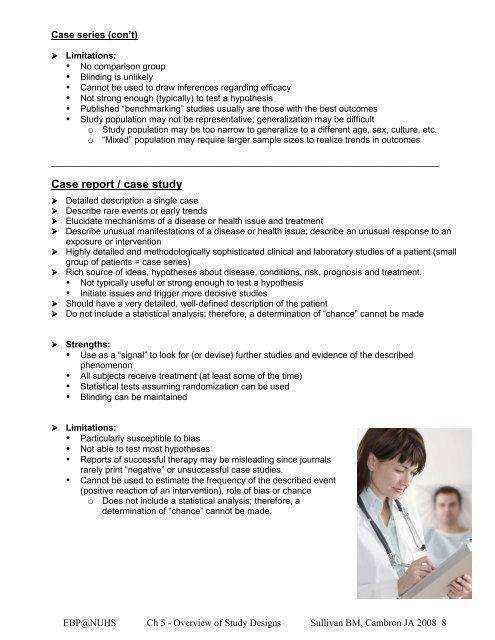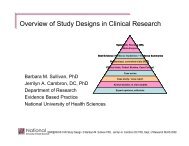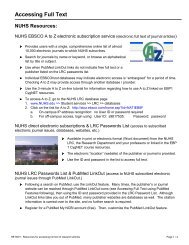Appraising the Literature Overview of Study Designs
Appraising the Literature Overview of Study Designs
Appraising the Literature Overview of Study Designs
Create successful ePaper yourself
Turn your PDF publications into a flip-book with our unique Google optimized e-Paper software.
Case series (con’t)<br />
Limitations:<br />
No comparison group<br />
Blinding is unlikely<br />
Cannot be used to draw inferences regarding efficacy<br />
Not strong enough (typically) to test a hypo<strong>the</strong>sis<br />
Published “benchmarking” studies usually are those with <strong>the</strong> best outcomes<br />
<strong>Study</strong> population may not be representative; generalization may be difficult<br />
o <strong>Study</strong> population may be too narrow to generalize to a different age, sex, culture, etc.<br />
o “Mixed” population may require larger sample sizes to realize trends in outcomes<br />
________________________________________________________________________________<br />
Case report / case study<br />
Detailed description a single case<br />
Describe rare events or early trends<br />
Elucidate mechanisms <strong>of</strong> a disease or health issue and treatment<br />
Describe unusual manifestations <strong>of</strong> a disease or health issue; describe an unusual response to an<br />
exposure or intervention<br />
Highly detailed and methodologically sophisticated clinical and laboratory studies <strong>of</strong> a patient (small<br />
group <strong>of</strong> patients = case series)<br />
Rich source <strong>of</strong> ideas, hypo<strong>the</strong>ses about disease, conditions, risk, prognosis and treatment.<br />
Not typically useful or strong enough to test a hypo<strong>the</strong>sis<br />
Initiate issues and trigger more decisive studies<br />
Should have a very detailed, well-defined description <strong>of</strong> <strong>the</strong> patient<br />
Do not include a statistical analysis; <strong>the</strong>refore, a determination <strong>of</strong> “chance” cannot be made<br />
Strengths:<br />
Use as a “signal” to look for (or devise) fur<strong>the</strong>r studies and evidence <strong>of</strong> <strong>the</strong> described<br />
phenomenon<br />
All subjects receive treatment (at least some <strong>of</strong> <strong>the</strong> time)<br />
Statistical tests assuming randomization can be used<br />
Blinding can be maintained<br />
Limitations:<br />
Particularly susceptible to bias<br />
Not able to test most hypo<strong>the</strong>ses<br />
Reports <strong>of</strong> successful <strong>the</strong>rapy may be misleading since journals<br />
rarely print “negative” or unsuccessful case studies.<br />
Cannot be used to estimate <strong>the</strong> frequency <strong>of</strong> <strong>the</strong> described event<br />
(positive reaction <strong>of</strong> an intervention), role <strong>of</strong> bias or chance<br />
o Does not include a statistical analysis; <strong>the</strong>refore, a<br />
determination <strong>of</strong> “chance” cannot be made.<br />
EBP@NUHS Ch 5 - <strong>Overview</strong> <strong>of</strong> <strong>Study</strong> <strong>Designs</strong> Sullivan BM, Cambron JA 2008 8





